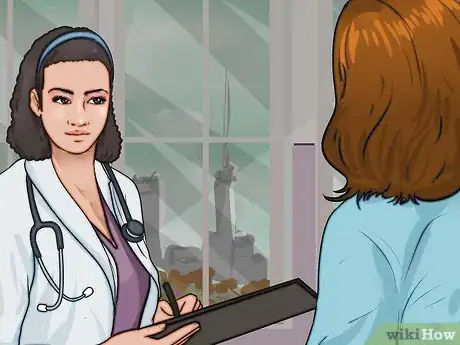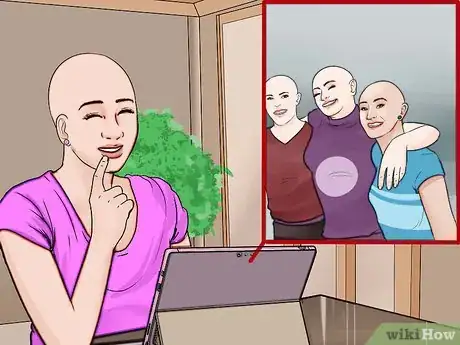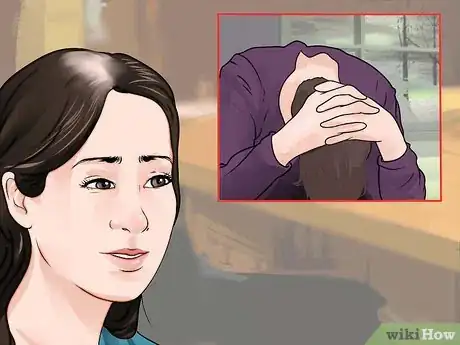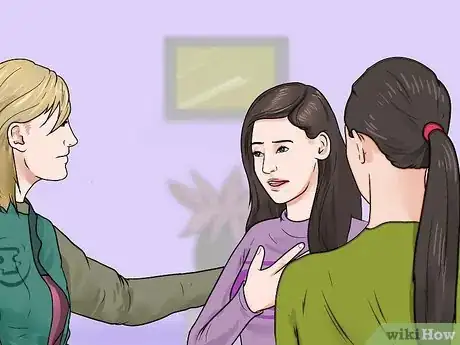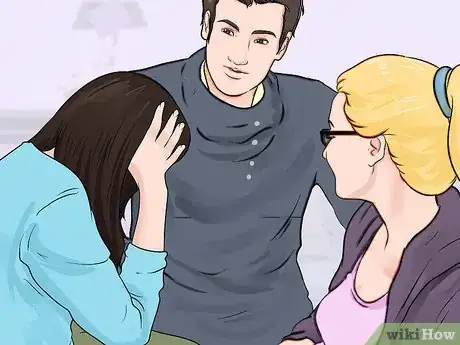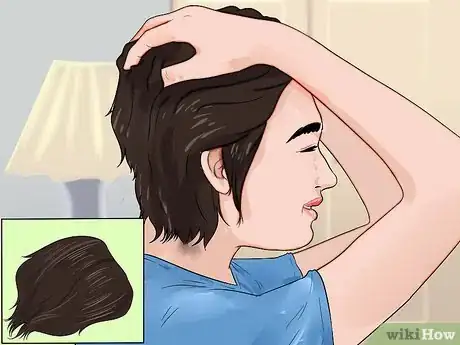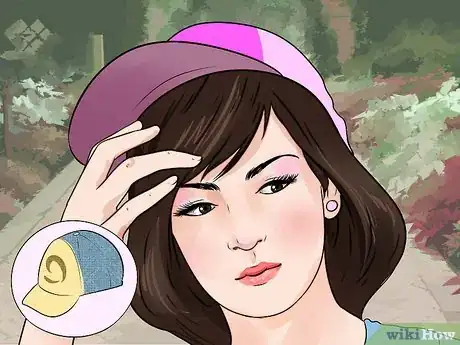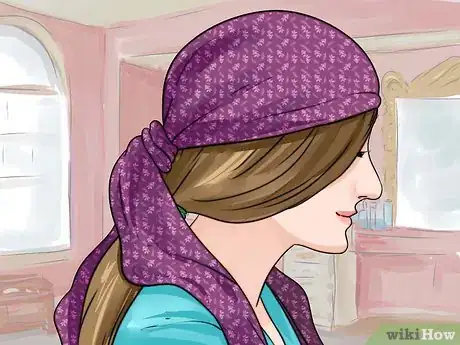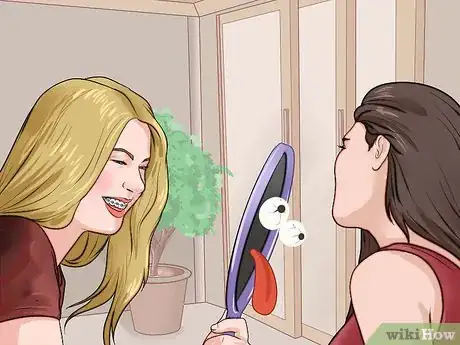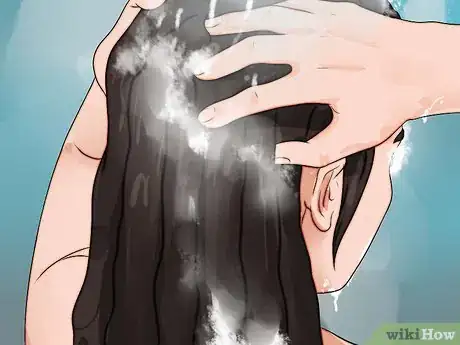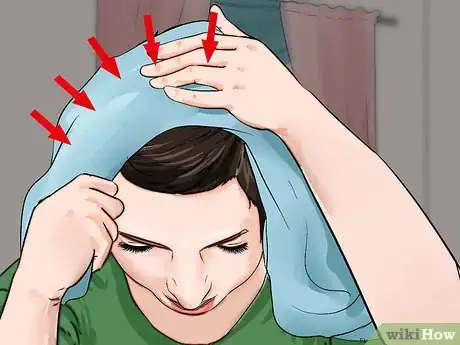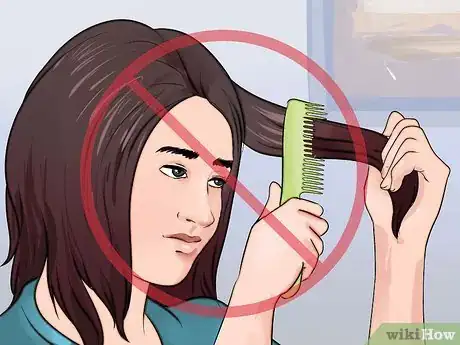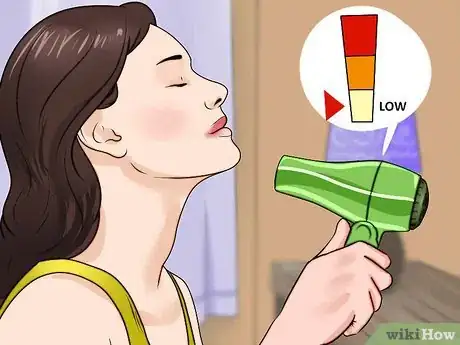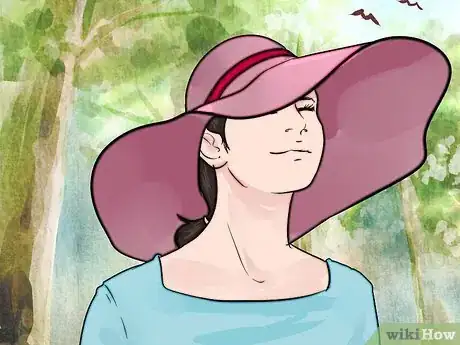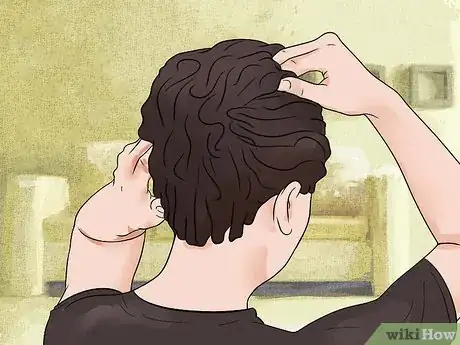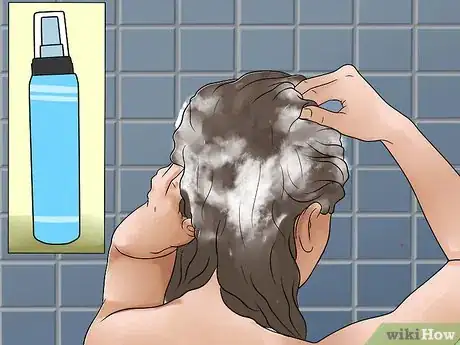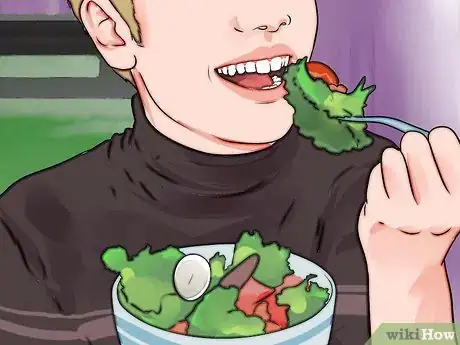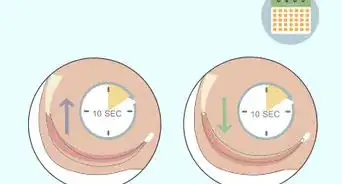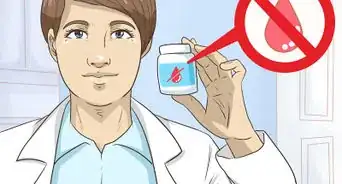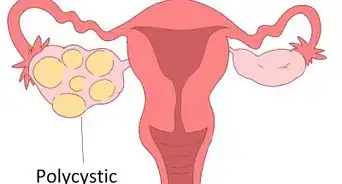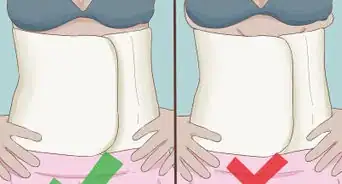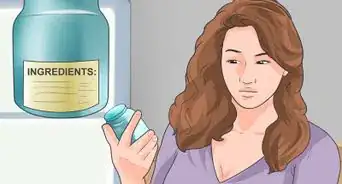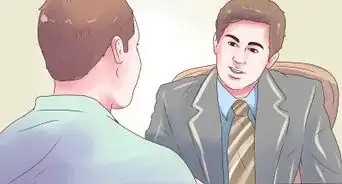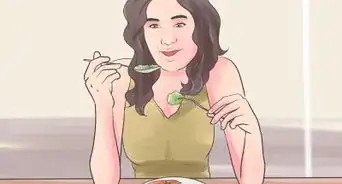This article was co-authored by Courtney Foster. Courtney Foster is a Licensed Cosmetologist, Certified Hair Loss Practitioner, and Cosmetology Educator based out of New York City. Courtney runs Courtney Foster Beauty, LLC and her work has been featured on The Wendy Williams Show, Good Morning America, The Today Show, The Late Show with David Letterman, and in East/West Magazine. She received her Cosmetology License from the State of New York after training at the Empire Beauty School - Manhattan.
There are 10 references cited in this article, which can be found at the bottom of the page.
This article has been viewed 59,261 times.
Men and women can experience hair loss or thinning locks at any age. Hair loss, which some people call balding, can be a product of conditions such as alopecia to treatments for cancer or even just age.[1] For women, hair loss may be especially distressing since many people associate beauty with hair. If you've experienced or are experiencing hair loss, coping with your baldness may be stressful. But with confidence and a little work, you can successfully deal with baldness and stimulate hair growth if possible.
Steps
Coping with Hair Loss
-
1See your doctor. If you have experienced hair loss or are currently going bald, it's important to see your doctor to find a cause.[2] It may be a product of cancer treatments or alopecia, or you may have an underlying disease that's causing your hair loss.[3]
- Your doctor may order blood tests to assess hormone levels that can cause hair loss.[4]
- If you are undergoing cancer treatments, your doctor may be able to tell you if your treatments can cause hair loss.
- Your doctor may also be able to prescribe you anti-depressants to help you overcome feelings of depression and anxiety for your hair loss.
-
2Embrace being bald. In some cases, your hair may never grow back. Although it make take a few months or longer, learning to embrace your baldness can help you cope with and overcome the condition.[5]
- Embracing your baldness won't happen overnight, in part because hair loss is often devastating. Gradually allow yourself to get used to your condition. For example, don't wear a wig, hat, or scarf at night or one day a week. You can build up to never using an aid or only on occasions when it's absolutely necessary.[6]
- There are different ways to help yourself embrace your hair loss. Consider giving yourself daily positive affirmations such as “I am strong and beautiful.” This can help bolster your confidence and may help you more readily accept your baldness.
- Consider taking an online course on how to cope. For example, the American Cancer Society offers several courses on how to best cope with self-esteem issues related to cancer.
- There are online forums from other groups such as the National Alopecia Areata Foundation which can put you in touch with other alopecia sufferers who can help bolster your confidence and accept your baldness.[7]
Advertisement -
3Be aware of social stigmas. Even though most people are socialized, there are often still social stigmas attached to baldness, especially in women. These stigmas can cause you shame, stress, anxiety, or depression. Addressing the negative connotations and your own feelings associated can help you move forward and lead a normal life.[8]
- Many people feel shame and embarrassment when they first experience hair loss. This is a completely normal initial reaction, but you should know that hair loss is fairly common and you don't need to feel this way.
- Seeing a counselor, doctor, or friend can help you deal with your feelings.
-
4Join a support group for sufferers of hair loss. Joining a support group of others who suffer from baldness can offer you unconditional support from others who understand what you're experiencing. It can also help you effectively deal with the various aspects of the condition.[9]
- Depending on the cause of your hair loss, there are support groups that can help you deal with a disease and the emotional side effects that come with losing your hair as a product of it. For example, cancer and alopecia support groups can offer significant support on this issue.
-
5Communicate with people. An important part of living with hair loss is talking with people about your baldness. Being open about your condition can help avoid uncomfortable questions or looks and may help you be more at ease as well.[10]
- Being open about your baldness or thinning hair is the best way to cope rather than fretting about it. When others realize that you're okay with your hair loss, then they will likely be, too.[11]
- It may also help to be open about what is causing your baldness. Sometimes simply saying something such as “I'm going through cancer treatments and they've caused me to lose my hair” can help relieve tension in situation or even minimize unwelcome glances from other people.
Using Different Styling Options
-
1Wear a wig or hairpiece.[12] If you are very distressed by your hair loss, consider wearing a wig or hairpiece. This may make you feel more comfortable in public or around friends and family members.[13]
- If your hair loss is a result of a medical condition, insurance may cover your wig if you get a prescription from your doctor.[14]
- You can get a wig or hairpiece at specialty hair or wig stores, or some salons.
- The American Cancer Organization and the National Alopecia Areata Foundation offer online programs that can help you find services to locate businesses in your area which provide wig and hairpiece support.[15]
-
2Put on a hat. Hats are great accessories that can cover up a bald head or thinning hair. Put on a hat if you don't want to wear a wig. Not only can this make you more confident, but it will distract others from your condition.[16]
- Some places, such as schools or offices, may forbid wearing head coverings. Ask your boss, principal or other authority to make an exception for your condition. You can get a doctor's note to help you with your request.
- There are many different types of hats to suit your style and taste, and even mood. You can purchase hats at most department and clothing stores, and even some large retailers.
-
3Wrap a scarf around your head. Tie a beautiful large scarf around your head. There are many different ways to wrap scarves, and an ingenious wrap and beautiful print can not only divert attention from your baldness, but also stimulate conversation and boost your confidence.[17]
- You can buy scarves at many department and clothing stores.
- There are hundreds of different ways to tie and wrap scarves around your head. A simple search on the Internet can help you find a style that suits your taste. Have fun with scarves!
-
4Divert attention. You can distract people from your baldness or thinning hair with hats, scarves, and wigs, or you can accentuate some aspect of your personality or even personal style. Getting people to notice something other than you lack of strands may help them—and you—cope with baldness.[18]
- You can divert attention with humor, your sparkling personality, or your stunning intellect.
- Consider wearing a vibrant outfit or piece of jewelry that will start conversations and distract people from your baldness.
Stimulating Hair Growth
-
1Wash your hair regularly and gently.[19] Clean your hair and scalp regularly and in a gentle manner with shampoo and conditioner. This can help you not only regrow your hair, but prevent damage that may cause further hair loss or impeded growth.[20]
- Wash your hair every other day or as little as necessary. Frequent washing can damage your strands.[21]
- Massage shampoo into your scalp and into the length of your hair.
- Rinse by allowing water to flow from your scalp down the ends of your hair. Don't rub your hair as it rinses, which may cause damage or hair loss.
- After you finish washing and rinsing your hair, apply a conditioner along the length of your hair from ends to scalp.[22]
-
2Dry your hair cautiously. Drying your hair and scalp with towels and hair dryers can cause damage and impede hair growth. Dry your hair with caution to help prevent breakage and promote regrowth.[23]
- After you've washed your hair, use a towel to lightly rub or pat your strands dry. Avoid the temptation to wrap your hair in a towel, which can damage your hair and cause breakage.[24]
- Let your hair or scalp air dry if possible.[25]
- If you use a hair dryer, use the lowest heat setting. Reducing the number of times per week that you use a hair dryer may help stimulate hair growth.[26]
-
3Avoid vigorous or frequent brushing and combing. If you brush or comb your hair, try and do this as infrequently and gently as possible. Reducing how often you brush or comb and changing the way in which you do it can help promote hair growth and prevent damage.[27]
- Only brush your hair to style it. It's a myth that you should brush your hair 100 strokes a day.[28]
- Allow your hair to air dry a bit before brushing or combing after washing.[29]
- Use a wide toothed comb to untangle wet hair. This will cause less damage than a brush.[30] If your hair is tangled, remove tangles gently and use a conditioner to help you if necessary.
-
4Style hair wisely. Many people style their hair or use styling products such as curling irons, which are often hotter than a dryer. If you have to style your hair, choose loose styles, avoid heavy products, and use lower heat tools.[31] [32]
- Pulling hair back tightly in ponytails or styles such as cornrows not only can break or damage hair, but also may cause hair loss. Wear your hair pulled back loosely and try different hairstyles every day to allow your hair and scalp to relax.[33]
- Use covered elastic bands to pull back your hair. Rubber can pull and break hair.[34]
- Avoid styling products that are labeled “long lasting hold”. These can damage hair and cause breakage.[35]
- If you use styling tools such as curling irons or hot combs, keep them at the lowest setting.[36]
- If you wear a weave or hair extensions, make sure they are light so that they don't pull at your hair and scalp.[37]
-
5Use chemical treatments sparingly or not at all. If you chemically treat your hair with color, perms, or relaxants, wait longer between treatments or avoid them altogether if you can. This can not only promote growth, but may also prevent damage and breaking.[38]
-
6Protect your hair and scalp from the sun. If you go outside frequently, use a sunscreen or large hat. This can not only protect your strands and scalp from the suns harmful rays, but may help promote hair growth and prevent breakage.[41]
-
7Stimulate growth with scalp massage. Rubbing your scalp stimulates and increases blood flow. Try getting a professional scalp massage or rub your own scalp to help prevent hair loss and promote growth.[44]
-
8Apply minoxidil to your scalp.[48] Minoxidil is an over the counter liquid or foam that you massage into your scalp twice daily. This medication may help promote hair growth or decease hair loss, or even both.[49]
- Men and women can use minoxidil and you don't need a prescription.[50]
- Regrowth peaks at about 16 weeks.[51] You need to continuously reapply minoxidil to maintain the benefits.[52]
- You may experience some side effects such as scalp irritation, rapid heart rate, and may even have some hair growth on the face and hands.[53]
- You can purchase minoxidil at most pharmacies and some grocery stores.
-
9Have surgery to restore or transplant hair. If medications and home treatments don't help hair regrowth, have hair transplant or restoration surgery. This can immediately help fill out thinning hair and can stimulate hair regrowth.[54]
- Hair transplants or restoration are procedures in which you doctor takes small plugs of hair from different parts of your scalp and implants them into thinner or bald sections.[55]
- You may need to take hair loss medication before surgery.[56]
- Hair transplants can be very painful and cause infection and scarring.[57]
- Be aware that hair transplants and restoration are expensive and insurance may not cover either procedure.[58]
-
10Eat a nutrient rich diet.[59] Your hair is an outward sign of your general health, and certain vitamins and minerals contribute to the health of your locks. Increase your intake of certain nutrients to help your hair grow and stay strong.[60]
- Protein is one of the building blocks of hair. Getting enough lean protein from meat, dairy products, fish, eggs, and nuts can help your hair get strong and grow.
- Iron helps prevent hair loss. You can get extra iron from red meat, fish, and chicken, as well as options such as lentils, kale, and broccoli.[61]
- Vitamin C helps the body absorb iron as well as produce collagen that can strengthen your hair shafts. Try eating blueberries, broccoli, oranges, and strawberries to get sufficient vitamin C.[62]
- Omega-3 fatty acids help keep the oils on your scalp, which in turn keep your hair hydrated. Get Omega-3s in fish such as salmon and trout, and other sources including avocado and pumpkin seeds.[63]
- A lack of zinc and/ or selenium can lead to hair loss. Eat fortified whole grains, oysters, beef, and eggs to get enough zinc to prevent hair loss.[64]
- Biotin helps keep hair strong and flexible. Too little may cause brittle hair or hair loss. You can get biotin from whole grains, liver, eggs, and yeast.[65]
Expert Q&A
-
QuestionWhat can I do to prevent baldness?
 Courtney FosterCourtney Foster is a Licensed Cosmetologist, Certified Hair Loss Practitioner, and Cosmetology Educator based out of New York City. Courtney runs Courtney Foster Beauty, LLC and her work has been featured on The Wendy Williams Show, Good Morning America, The Today Show, The Late Show with David Letterman, and in East/West Magazine. She received her Cosmetology License from the State of New York after training at the Empire Beauty School - Manhattan.
Courtney FosterCourtney Foster is a Licensed Cosmetologist, Certified Hair Loss Practitioner, and Cosmetology Educator based out of New York City. Courtney runs Courtney Foster Beauty, LLC and her work has been featured on The Wendy Williams Show, Good Morning America, The Today Show, The Late Show with David Letterman, and in East/West Magazine. She received her Cosmetology License from the State of New York after training at the Empire Beauty School - Manhattan.
Licensed Cosmetologist Try to avoid using high-heat styling tools since they could damage your hair. You should also wear looser styles so you don't put tension on your hair.
Try to avoid using high-heat styling tools since they could damage your hair. You should also wear looser styles so you don't put tension on your hair.
References
- ↑ http://www.mayoclinic.org/diseases-conditions/hair-loss/basics/treatment/con-20027666
- ↑ Courtney Foster. Licensed Cosmetologist. Expert Interview. 9 December 2019.
- ↑ https://www.aad.org/dermatology-a-to-z/diseases-and-treatments/e---h/hair-loss/tips
- ↑ http://www.mayoclinic.org/diseases-conditions/hair-loss/basics/treatment/con-20027666
- ↑ https://www.nhs.uk/conditions/hair-loss/coping-tips-for-women/
- ↑ https://www.nhs.uk/conditions/hair-loss/coping-tips-for-women/
- ↑ https://www.naaf.org/find-support
- ↑ https://www.nhs.uk/conditions/hair-loss/coping-tips-for-women/
- ↑ https://www.nhs.uk/conditions/hair-loss/coping-tips-for-women/
- ↑ https://www.nhs.uk/conditions/hair-loss/coping-tips-for-women/
- ↑ https://www.nhs.uk/conditions/hair-loss/coping-tips-for-women/
- ↑ Courtney Foster. Licensed Cosmetologist. Expert Interview. 9 December 2019.
- ↑ http://www.mayoclinic.org/diseases-conditions/hair-loss/basics/treatment/con-20027666
- ↑ http://www.mayoclinic.org/diseases-conditions/hair-loss/basics/treatment/con-20027666
- ↑ http://www.cancer.org/treatment/supportprogramsservices/index
- ↑ https://www.nhs.uk/conditions/hair-loss/coping-tips-for-women/
- ↑ https://www.nhs.uk/conditions/hair-loss/coping-tips-for-women/
- ↑ https://www.nhs.uk/conditions/hair-loss/coping-tips-for-women/
- ↑ Courtney Foster. Licensed Cosmetologist. Expert Interview. 9 December 2019.
- ↑ https://www.aad.org/dermatology-a-to-z/diseases-and-treatments/e---h/hair-loss/tips
- ↑ https://www.aad.org/dermatology-a-to-z/diseases-and-treatments/e---h/hair-loss/tips
- ↑ https://www.aad.org/dermatology-a-to-z/diseases-and-treatments/e---h/hair-loss/tips
- ↑ https://www.aad.org/dermatology-a-to-z/diseases-and-treatments/e---h/hair-loss/tips
- ↑ https://www.aad.org/dermatology-a-to-z/diseases-and-treatments/e---h/hair-loss/tips
- ↑ https://www.aad.org/dermatology-a-to-z/diseases-and-treatments/e---h/hair-loss/tips
- ↑ https://www.aad.org/dermatology-a-to-z/diseases-and-treatments/e---h/hair-loss/tips
- ↑ https://www.aad.org/dermatology-a-to-z/diseases-and-treatments/e---h/hair-loss/tips
- ↑ https://www.aad.org/dermatology-a-to-z/diseases-and-treatments/e---h/hair-loss/tips
- ↑ https://www.aad.org/dermatology-a-to-z/diseases-and-treatments/e---h/hair-loss/tips
- ↑ https://www.aad.org/dermatology-a-to-z/diseases-and-treatments/e---h/hair-loss/tips
- ↑ Courtney Foster. Licensed Cosmetologist. Expert Interview. 9 December 2019.
- ↑ https://www.aad.org/dermatology-a-to-z/diseases-and-treatments/e---h/hair-loss/tips
- ↑ https://www.aad.org/dermatology-a-to-z/diseases-and-treatments/e---h/hair-loss/tips
- ↑ https://www.aad.org/dermatology-a-to-z/diseases-and-treatments/e---h/hair-loss/tips
- ↑ https://www.aad.org/dermatology-a-to-z/diseases-and-treatments/e---h/hair-loss/tips
- ↑ https://www.aad.org/dermatology-a-to-z/diseases-and-treatments/e---h/hair-loss/tips
- ↑ https://www.aad.org/dermatology-a-to-z/diseases-and-treatments/e---h/hair-loss/tips
- ↑ https://www.aad.org/dermatology-a-to-z/diseases-and-treatments/e---h/hair-loss/tips
- ↑ https://www.aad.org/dermatology-a-to-z/diseases-and-treatments/e---h/hair-loss/tips
- ↑ https://www.aad.org/dermatology-a-to-z/diseases-and-treatments/e---h/hair-loss/tips
- ↑ https://www.aad.org/dermatology-a-to-z/diseases-and-treatments/e---h/hair-loss/tips
- ↑ https://www.aad.org/dermatology-a-to-z/diseases-and-treatments/e---h/hair-loss/tips
- ↑ https://www.aad.org/dermatology-a-to-z/diseases-and-treatments/e---h/hair-loss/tips
- ↑ http://www.pacificcollege.edu/news/blog/2015/02/01/benefits-scalp-massage-hair-loss
- ↑ http://www.pacificcollege.edu/news/blog/2015/02/01/benefits-scalp-massage-hair-loss
- ↑ http://www.pacificcollege.edu/news/blog/2015/02/01/benefits-scalp-massage-hair-loss
- ↑ http://www.pacificcollege.edu/news/blog/2015/02/01/benefits-scalp-massage-hair-loss
- ↑ Courtney Foster. Licensed Cosmetologist. Expert Interview. 9 December 2019.
- ↑ http://www.mayoclinic.org/diseases-conditions/hair-loss/basics/treatment/con-20027666
- ↑ http://www.mayoclinic.org/diseases-conditions/hair-loss/basics/treatment/con-20027666
- ↑ http://www.mayoclinic.org/diseases-conditions/hair-loss/basics/treatment/con-20027666
- ↑ http://www.mayoclinic.org/diseases-conditions/hair-loss/basics/treatment/con-20027666
- ↑ http://www.mayoclinic.org/diseases-conditions/hair-loss/basics/treatment/con-20027666
- ↑ http://www.mayoclinic.org/diseases-conditions/hair-loss/basics/treatment/con-20027666
- ↑ http://www.mayoclinic.org/diseases-conditions/hair-loss/basics/treatment/con-20027666
- ↑ http://www.mayoclinic.org/diseases-conditions/hair-loss/basics/treatment/con-20027666
- ↑ http://www.mayoclinic.org/diseases-conditions/hair-loss/basics/treatment/con-20027666
- ↑ http://www.mayoclinic.org/diseases-conditions/hair-loss/basics/treatment/con-20027666
- ↑ Courtney Foster. Licensed Cosmetologist. Expert Interview. 9 December 2019.
- ↑ http://www.bbcgoodfood.com/howto/guide/what-eat-healthy-hair
- ↑ http://www.bbcgoodfood.com/howto/guide/what-eat-healthy-hair
- ↑ http://www.bbcgoodfood.com/howto/guide/what-eat-healthy-hair
- ↑ http://www.bbcgoodfood.com/howto/guide/what-eat-healthy-hair
- ↑ http://www.bbcgoodfood.com/howto/guide/what-eat-healthy-hair
- ↑ http://www.bbcgoodfood.com/howto/guide/what-eat-healthy-hair
About This Article
If you're a woman who's experiencing hair loss, it's a good idea to talk to your doctor, since you might be losing hair because of an underlying condition that can be treated. There are also things you can do at home to stimulate hair growth, like applying minoxidil to your scalp, which is an over-the-counter treatment that promotes hair growth. Additionally, make sure you're eating a healthy, balanced diet since vitamins and minerals can make your hair healthier and stronger. You should also try your best to avoid chemical hair treatments and heat styling tools since they can make hair loss worse. For a more drastic approach, talk to your doctor about hair restoration surgery, which can help fill out thinning hair. For tips from our Medical co-author, like how to embrace baldness, keep reading.
